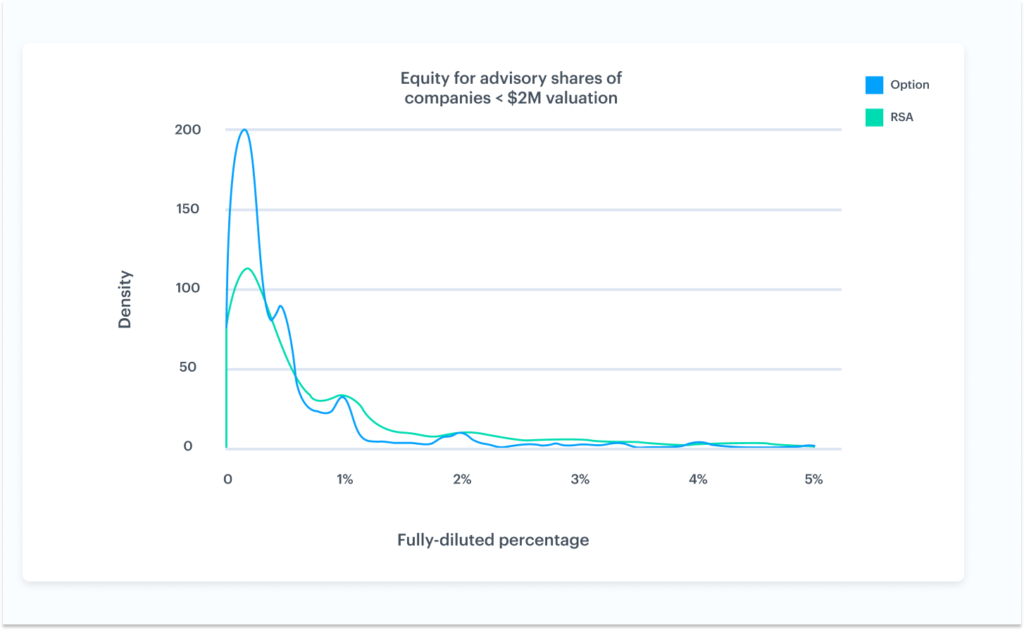Advisors can offer valuable advice when your company is in a formative place. Most startups (especially pre-seed, idea-stage ones) don’t have the cash on hand to adequately compensate advisors, so equity emerges as the natural solution: give the people who help you grow a certain percentage of the company to reward them in the long-term.
But handing out equity, even to close advisors, is something founders need to do conscientiously.
Here’s a guide to help you figure out how to approach advisors and their incentives:
How to approach the conversation about equity
The advisor agreement (free advisor template)
How much equity do advisors get?
Vesting schedule for advisor shares
Types of advisors
Pick your advisors like you would a co-founder. At best, an advisor can be critical to your success as a company; at worst, they can be a distraction and waste of precious time, or even a liability. Know what you’re getting into by identifying the type of advisor you want:
- The name advisor. Your main benefit from this type of advisor is through association. Maybe they’re a well-known name who can provide connections to their network or boost your startup’s profile.
- The practical advisor. Think of this advisor as your sounding board. They can help with specific work—from hiring and go-to-market strategy to partnerships and more. You can turn to them for help to talk through an idea, big or small.
The key to any advisory relationship is figuring out the right fit. You’ll know within a couple of months if it’s going to be fruitful. It’s also not uncommon for advisors to ask about following-on future financing rounds with their own money, investing directly in the company. Advisors get a unique look at the high-level operations of a company and if they like what they see, and have the resources, they may want to buy in. Sometimes advisors even go on to become key employees at the company.
Clayton Bryan is a Venture Partner at 500 Startups. He advises early stage companies to not just look for someone who can advise temporarily but for someone who can “teach and maybe groom someone that’s junior. So they can speed up that learning curve and then the company can begin to execute at a much faster clip.”
How to find startup advisors
First, figure out what you want in an advisor. You want someone who can help compensate for a weakness you have.
“You’re basically creating a job description,” says Clayton, “and you want to kind of shop around for advisors.” For example, if it’s your first time fundraising, it could be helpful to have the ear of someone who’s done it a few times. If your B2B team is strong in data and engineering, you may want someone who has experience selling to Fortune 500 companies. “Find an advisor that fits not only what’s on paper,” says Clayton, “but also fits your culture and can work with you.”
Once you have the idea of what you’re looking for, reach out to your network. Ask former colleagues, current investors, and other founders for recommendations. Research your market and find experts who are helpful. Sometimes a successful relationship can begin with a customized LinkedIn message or cold email.
How to approach the conversation about equity
Before promising equity, it’s worth asking a potential advisor if they would invest in your company instead of taking equity. Investing directly gives them more skin in the game and sends a valuable signal to future investors as well.
It’s not a good sign if equity is the first subject brought up. Have a couple of conversations first. Amit Bhatti, a lawyer and Principal at 500 Startups, believes it only makes sense to give equity “because of how helpful somebody has been or the founder feels like they’re going to be demanding on somebody’s time.” That’s the time to formally establish the relationship.
Experienced advisors might have a framework they’ve used before—once it comes time to talk compensation, they may offer a structure they’re familiar with. It’s up to you to determine if it makes sense for your company. If it doesn’t, work with your lawyer and the advisor to figure out an arrangement that works. If you do decide to provide equity, keep in mind the advisor’s level of expertise and the stage your company is at when figuring out the amount.
The advisor agreement (free advisor template)
The goals of an advisor relationship can be pretty unclear. Help you and your advisor get aligned by putting together a signed agreement that lays out:
- The advisor’s domain of expertise
- What they’re going to help you with
- What percentage of equity (if any) they’ll get, or other compensation
The FAST agreement by Founder Institute was a good starting place, but their suggestions for percentage allocation may be a little simplistic, and it doesn’t contain some standard protections for companies. Since the FAST agreement was last updated (2017), several laws, including around employment, have changed.
This is why we asked the team at Wilson Sonsini, one of the premier law firms in the world, to put together a sample agreement for founders and business advisors to use as a model. You can download the template below, for free:

Download the advisor agreement template
This advisor agreement sample has been prepared by Wilson Sonsini for informational purposes only.
Whatever decision you come to with your advisor, make sure to document the agreement. Especially if equity is involved or promised. We recommend you talk to a lawyer and work with your potential advisor on an agreement that works for everyone.
Advisor relationships need to be founder driven. “Founders are the ones driving the cadence [of communication].” says Clayton, “They’re the ones building the agendas and holding the expectations in terms of interacting with that advisor.”
Types of advisor equity
Advisors typically get shares of common stock, just like employees, which are subject to vesting during the working relationship. Usually they either get:
- Restricted stock agreements (RSAs) – which are usually issued (sometimes at a small cost) when a company hasn’t raised much money or anything at all.
- Or non-qualified stock options (NSOs) – which is the right to buy shares at a predetermined “strike” or “exercise” price.
How much equity do advisors get?
Many suggestions for the amount of equity to allocate individual advisors come from anecdotal experience. But at Carta, we have data that provides real insight into what’s actually happening. So we looked at advisor shares issued in 2019 for companies that have raised under $2 million. Here are the most common arrangements we saw:
- Advisor RSAs: From 0.2% to 1% of a company
- Advisor NSOs: From 0.1% to 0.5% of a company

Here is a density plot of NSO and RSA advisor agreements for companies on Carta in 2019 that have raised less than $2M. The X-axis represents the fully-diluted percentage of a company. The lines have been normalized, so while it looks like option agreements have been issued above the ranges we describe above, they are not common.
RSAs appear to have a larger percentage because they are usually issued soon after incorporation, before there is any increase in the fair market value of a company. The earlier an advisor joins a company, the higher the fully-diluted amount they’ll usually be granted.
The difference between RSAs and NSOs is largely a legal distinction. RSAs are shares bought upfront, and NSOs are options to buy shares, which are usually awarded later on.
Vesting schedule for advisor shares
A vesting schedule for advisors, just like you have for yourself and your employees, is crucial. These agreements often have a two year schedule, vesting monthly, with no cliff.
“Vesting doesn’t make sense for advisors the same way it does for employees” says Amit. That’s because companies change quickly and the advisors you need at the seed stage will likely be different than the ones you want at Series B and beyond.
Avoid a four year schedule because most advisors are going to deliver most of their value up front. You can always re-visit the relationship after a year or two and see if you want to keep going forward.
Some agreements have a cliff of three months, which gives the parties time to sort out if the relationship will deliver value and work out.
Remember
Founders, before you give equity to an advisor, decide if it’s worth it. If you are generating revenue, can you afford to pay them instead? If you can’t afford them, an equity agreement could be the start of a helpful partnership. Early-stage companies can check out Carta Launch if they need help issuing equity whether it’s to advisors, investors, or employees.
Ultimately, it’s all about how you’ll use the advisor. You have to tell them what you need and expect. Find someone who can be a sounding board, who can help level-up your company.
Thank you to Ray Raff, Reed McBride, Becki DeDraw, and Alyssa Frederick for their contributions to this post.
Companies who have contractually requested that we not use their data in anonymized and aggregated studies are not included in this analysis.
DISCLOSURE: This publication contains general information only and eShares, Inc. dba Carta, Inc. (“Carta”) is not, by means of this publication, rendering accounting, business, financial, investment, legal, tax, or other professional advice or services. This publication is not a substitute for such professional advice or services nor should it be used as a basis for any decision or action that may affect your business or interests. Before making any decision or taking any action that may affect your business or interests, you should consult a qualified professional advisor. This communication is not intended as a recommendation, offer or solicitation for the purchase or sale of any security. Carta does not assume any liability for reliance on the information provided herein.




